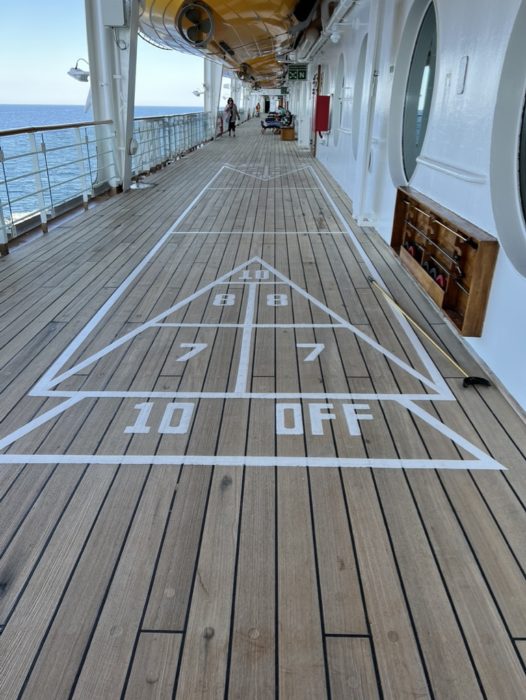FAQ: Coping with Motion Sickness on Your Ocean Cruise
First things first – while many new ocean cruisers are nervous about seasickness, experiencing motion sickness symptoms on an ocean liner is by no means a given. Today’s large ocean cruise ships are equipped with advanced motion stabilizer technology. Depending on your itinerary, you may feel virtually no movement of the ship at all. That said, there are some people who are particularly susceptible to adverse effects at sea. Here’s everything you need to know about coping with the motion of the ocean.
Please note: I am not a doctor. Consult with a medical professional if your case is severe or if you have any concerns about combining motion sickness solutions with other medical issues. And of course, be particularly aware that early pregnancy can add layers of nuance to motion sickness and requires extra care with finding a solution.
What is motion sickness?
According to the U.S. Centers for Disease Control, “Motion sickness happens when the movement you see is different from what your inner ear senses. This can cause dizziness, nausea, and vomiting. You can get motion sick in a car, or on a train, airplane, boat, or amusement park ride.”
Who is most likely to experience motion sickness symptoms?
Approximately one in three people experience motion sickness at some point in their lifetime. Women and children age 2 to 12 are most at risk, but it can happen to anyone.
You’re more likely to find yourself with motion sickness at sea if you experience it in other situations such as on roller coasters or when you’re reading in a car. Other factors that may increase your chances of getting motion sickness are a family history of motion sickness, a history of inner ear disorders, frequent migraines, Parkinson’s disease, pregnancy, or if you’re taking medication such as blood pressure or hormone therapies that include dizziness as a known side effect.
If you’re concerned that you may have motion sickness at sea, speak to your doctor prior to sailing. Also, remember that children may have symptoms that need remediation. A call to your kids’ pediatrician may be in order.

Will my stateroom location impact motion sickness?
The rule of thumb is that midship staterooms experience the least rocking, followed by aft and then forward staterooms. Lower decks are more stable than high decks. If you’re prone to motion sickness, a Deck 2 midship cabin may be more comfortable than a Deck 9 forward cabin. The exception to this might be if you find that fresh air helps you, in which case a midship stateroom with a verandah on deck five or six might be your best bet.

Are there itineraries that are more likely to induce motion sickness?
Ocean liners have stabilizers and other technology that keep motion to a minimum, and the navigation staff does as much as possible to minimize the impact of weather on ship motion. Most of the time, you’ll feel no different on the ship than you would if you were strolling across your own front yard.
Motion sickness is least likely on larger ships and when you’re moving slowly in calm waters, for example in the Alaskan straits, Norwegian fjords, or along the Mediterranean coast. The Caribbean is generally placid, except during hurricane season, which typically runs from June through November. Motion sickness is more likely on smaller ships and on long expanses of open water such as transatlantic crossings.
If you tend toward motion sickness on land and are considering a first cruise, start with a shorter itinerary with minimal days at sea.
Are there things I can do to make motion sickness less likely?
There are a number of things you can do to help derail motion sickness before it starts. These include:
- Eat lightly. If eating lightly isn’t an option during your entire vacation because, well, vacation, try to arrange for your high-motion activities to take place early in the day, prior to any big meals.
- Stay hydrated.
- Wash your hands often. An upset stomach can start with germ-based problems that become exacerbated with motion.
- Make good choices in port. Similarly, make choices in port that will minimize the likelihood of tummy troubles. For example, stick with bottled water and cooked foods and avoid port adventures involving things like rides on small boats or jeep trips down bumpy roads.
- Limit alcohol consumption. Again, you’ll want to cut down on other potential sources of lightheadedness.

Is there anything I can do to prepare for motion sickness?
You’re less likely to feel motion sickness effects if you focus your eyes on a fixed spot and keep your head and neck as still as possible. Many people also find the sensation of air blowing across their faces to be helpful. Beyond that, here are some motion sickness solutions that are things you can take or use to prepare:
- Take antacids. Tums and Zantac are popular brands
- Take ginger supplements. Many brands. Widely available at drugstores and online. Ginger ale is available on the ships.
- Take Queasy Pops or Queasy Drops. Available at drugstores and online to soothe a queasy tummy.
- Smell peppermint or spearmint essential oils. Many brands. Available at drugstores and online.
- Use Seabands. Acupressure wristband. Available at drugstores and online.
- Use Motion Sickness eyeglasses. Available from Boarding Glasses and other online sources.
- Use electrical stimulation bands. Available from Reliefbands.
- Take Meclizine Hydrochloride. A common brand name is Bonine. Widely available at drugstores and online.
- Take Dimenhydrinate. A common brand name is Dramamine. Widely available at drugstores and online.
- Use Scopolamine. A patch, worn behind the ear. Must be prescribed by a doctor. Known to have an array of often troubling side effects; speak with your prescriber about this.
- Eat green apples. Ships stock these to give to guests with motion issues.

What should I do if I find myself nauseous at sea?
Rehydrate with plain water or with an electrolyte beverage such as PowerAde and try a bland, non-greasy snack such as saltines or toast.
Over-the-counter medications like Dramamine and Bonine are stocked on most ocean liners. If the ship’s shops are not open, stop by the Guest Services desk onboard. They may be able to provide you with a few doses to tide you over.
Guests who know they are prone to vomiting with motion sickness will want to keep a disposable plastic bag with them at all times.

When should I enlist onboard medical assistance?
A vanishingly small number of cruisers experience severe symptoms. Large ocean vessels sail with a clinic and onboard medical personnel. Speak with them if you have persistent vomiting or signs of dehydration.
Any other tips?
Some travelers simply can’t tolerate any movement on an ocean ship. If you fall into this category, you might want to consider a river cruise as an alternative. River cruises, such as those offered by Adventures by Disney move slowly along still river waters. Motion sickness is exceedingly rare on these sailings.
Are you prone to motion sickness at sea? What are your favorite tips? Let us know in the comments!






First time cruising, and really worried about my vertigo while on ship. Suggestions???